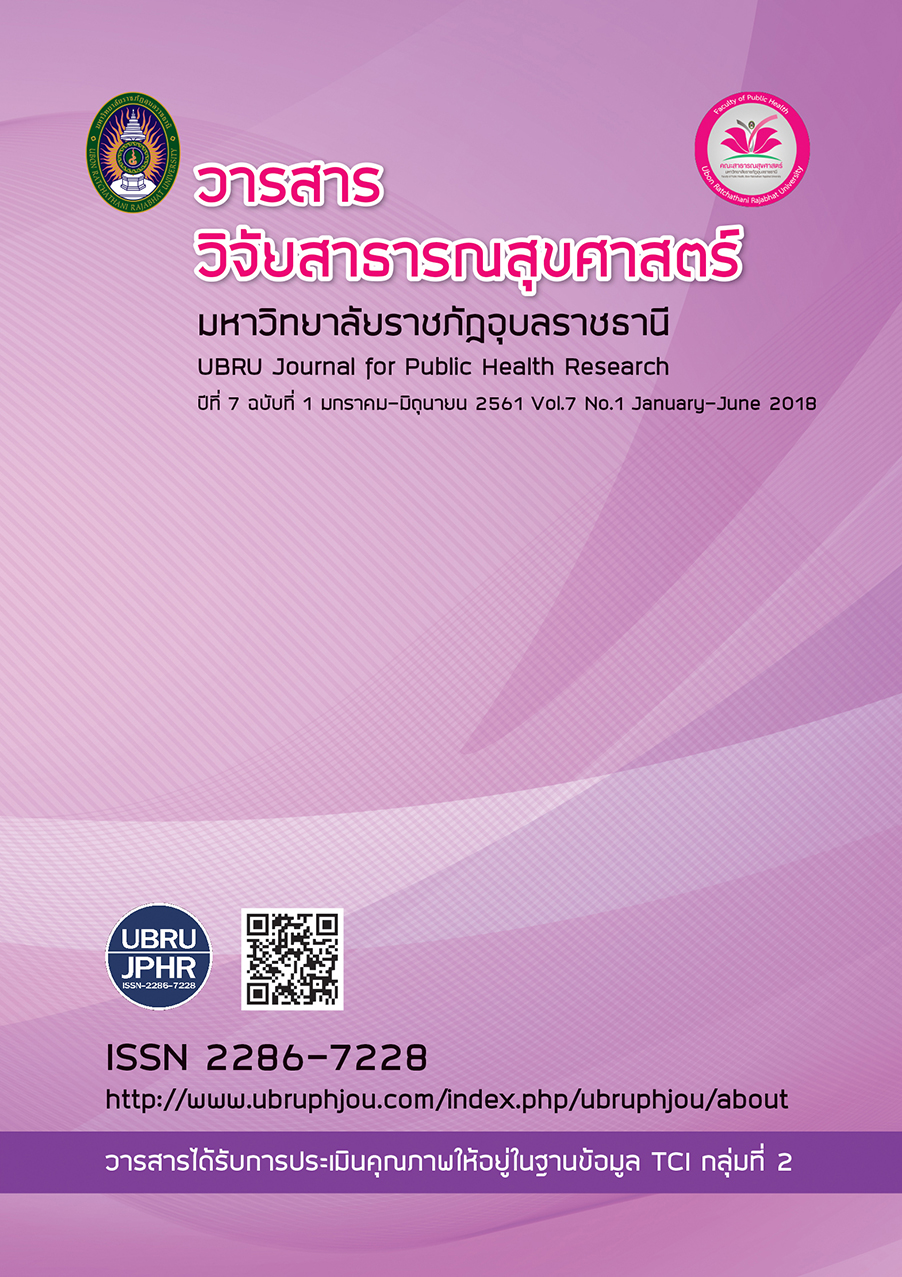The patterns of enterprise master metabolic Ekpayan School, Kalasin Province
Keywords:
Obesity, participation, model organization of metabolic syndromeAbstract
This was an action research study. The purpose of this study was to investigate the pattern of operation of the prototype organization of the School in Kalasin Province By in the study a group of School personnel. The 95 person cent risk of obesity was defined by 4 steps of action planning, observation, and reflection, by engaging the personnel with the formation process, Diagnose problems, plan and solve problems together. Collect quantitative and qualitative data using questionnaire and group discussion. Data was analyzed using percentage, mean, standard deviation The study indicated that the staff at Ekpanya School changed their level of knowledge about health behavior, food, emotions, exercise, non-smoking and non-alcohol drinking, increased knowledge and behavior change. There was a high level of perceived self-efficacy in participation. Personnel body mass index decreased and the waistline decreased performance objectives are achieved through the implementation of an unmanned prototype organization, by engaging, personnel, working together, and driving a seamless corporate policy. In summary, the success factor is personnel can support school activities according to their potential and roles. Consequently,there should be continuous work to properly change the behavior of the health and to develop a continuous model of a seamless prototype organization to benefit the school in further development.
References
กองสุขศึกษา กระทรวงสาธารณสุข. (2548). แนวทางสร้างสุขภาพ: พฤติกรรมที่พึง ประสงค์ตามสุขบัญญัติแห่งชาติ 10 ประการ. กรุงเทพฯ: กองสุขศึกษา กรมสนับสนุนบริการสุขภาพ.
จิตติมา ธาราพันธ. (2550). รูปแบบการส่งเสริมสุขภาพสําหรับกลุ่มอาการเมตาบอลิค. ราชบุรี: ศูนย์อนามัยที่ 4 ราชบุรี กรมอนามัย กระทรวงสาธารณสุข.
จันทร์เพ็ญ ชูประภาวรรณ. (2547). สถานะสุขภาพคนไทย. นนทบุรี: สำนักพิมพ์ไทยวัฒนา.
โฉมยุพา เศรษฐี และสมยศ แสงหิ่งหอย. (2551). การพัฒนารูปแบบการแก้ไขภาวะอ้วนลงพุงด้วยค่ายพิชิตอ้วนพิชิตพุงในจังหวัดอ่างทอง. วารสารโรคและภัยสุขภาพ สคร.8. 2(3): 54-68.
ประเวศ วะสี. (2541). บนสาธารณสุขเส้นทางใหม่ : การส่งเสริมสุขภาพชีวิตและสังคม. กรุงเทพฯ: สำนักพิมพ์หมอชาวบ้าน.
มารดี วิทยาดํารงชัย. (2549). กระบวนการพัฒนาเครือข่ายสุขภาพ โดยการมีส่วนร่วมของชุมชนบ้าน หลักศิลาเหนือ จังหวัดนครพนม. วิทยานิพนธ์สาธารณสุขศาสตรมหาบัณฑิต สาขาวิชาการจัดการระบบสุขภาพ มหาวิทยาลัยมหาสารคาม.
วาณี โพธิ์นคร และศรีสุดา เอกลัคนารัตน์. (2548). การออกกําลังกายและการบริโภคอาหารของเด็กนักเรียนที่มีภาวะโภชนาการเกิน. กรุงเทพฯ: วิทยาลัยพยาบาลบรมราชชนนี.
ศรีสุดา เอกลัคนารัตน์ และธนัชฌา ภัยพยบ์. (2549). ผลของการสร้างพลังอํานาจโดยการให้บริการปรึกษาแบบกลุ่มต่อการปรับเปลี่ยนพฤติกรรมการออกกําลังกายและการบริโภคอาหารของวัยรุ่นที่มีภาวะโภชนาการเกิน. กรุงเทพฯ: วิทยาลัยพยาบาลบรมราชชนนี.
สำนักงานสาธารณสุขอำเภอสมเด็จ. (2557). สรุปสถานการณ์ปัญหาโรคอ้วนโรงเรียนเอกปัญญาอำเภอสมเด็จ จังหวัดกาฬสินธุ์. กาฬสินธุ์: สำนักงานสาธารณสุขอำเภอสมเด็จ.
สำนักโรคไม่ติดต่อ กรมควบคุมโรค. (2556). ปัญหาสุขภาพของคนไทยโรคเรื้อรัง โรคไม่ติดต่อ. กรุงเทพฯ: สำนักโรคไม่ติดต่อกรมควบคุมโรค.
สมชาย ลี่ทองอิน. (2549). สถานการณ์สุขภาพของประชากรวัยทํางาน. นนทบุรี: สำนักส่งเสริมสุขภาพกรมอนามัย กระทรวงสาธารณสุข.
Green, L.W. and Kreuter, M.W. (1999). Health Promotion Planning an Educational and Ecological Approach. 3rded. Toronto: Mayfield.
World Health Organization. (2016 ). Obesity Preventing and Managing the Global Epidemic. Geneva: WHO Press.
Downloads
Published
How to Cite
Issue
Section
License
เนื้อหาและข้อมูลในบทความที่ลงตีพิมพ์ในวารสารวารสารวิจัยสาธารณสุขศาสตร์ มหาวิทยาลัยราชภัฏอุบลราชธานี ถือเป็นข้อคิดเห็นและความรับผิดชอบของผู้เขียนบทความโดยตรงซึ่งกองบรรณาธิการวารสาร ไม่จำเป็นต้องเห็นด้วย หรือร่วมรับผิดชอบใดๆ
บทความ ข้อมูล เนื้อหา รูปภาพ ฯลฯ ที่ได้รับการตีพิมพ์ในวารสารนี้ ถือเป็นลิขสิทธิ์ของวารสารฯ หากบุคคลหรือหน่วยงานใดต้องการนำทั้งหมดหรือส่วนหนึ่งส่วนใดไปเผยแพร่ต่อหรือเพื่อกระทำการใดๆ จะต้องได้รับอนุญาตเป็นลายลักอักษรณ์จากบรรณาธิการวารสารนี้ก่อนเท่านั้น

